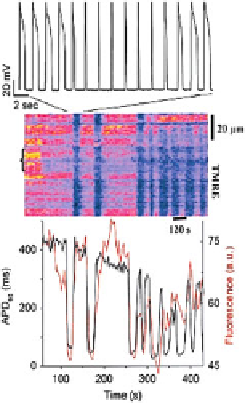Biology Reference
In-Depth Information
Experiment
Model
a
c
24
150
8.0
ATPi
IK
ATP
ΔΨ
m
120
7.8
18
90
7.6
12
60
7.4
6
30
7.2
0
0
7.0
120
130
140
150
160
b
660
60
30
30
0
0
-30
-30
APD
90
=43mS
APD
90
=170mS
-60
-60
-90
-90
124.0
124.1
124.2
124.3
138.0
138.1
138.2
138.3
Time (msec)
Fig. 5.10 Effects of mitochondrial oscillation on the electrical excitability of the cardiomyocyte
(a) Action potentials (AP,
upper panel
) evoked by brief current injections were recorded in current
clamp mode during whole-cell patch clamp while simultaneously imaging
ΔΨ
m
with TMRE
(
lower panel
). During a synchronized cell-wide depolarization-repolarization cycle, the AP
shortened in synchrony with fast mitochondrial depolarization, and the cell became unexcitable
in the fully depolarized state (remaining upward spikes are from the stimulus only). Recovery of
ΔΨ
m
coincided with restoration of AP. (b) Temporal correlation between the AP duration at 90 %
repolarization and
m
. The current-voltage relationship of the oscillatory membrane current fits
the profile of the sarcolemmal K
ATP
current (Aon et al.
2003
). (c) Simulations of
ΔΨ
m
, cytoplas-
mic ATP concentration ([ATP]i) and sarcolemmal K
ATP
current during oscillations triggered by
oxidative stress, and comparison of APs during polarized and depolarized states. Modified from
Aon, Cortassa, Marban, O'Rourke (2003) J Biol Chem 278, 44735-44, and Zhou, Cortassa, Wei,
Aon, Winslow, O'Rourke (2009) Biophys J 97, 1843-1852
ΔΨ
triggered by ROS was shown experimentally to be coupled to the opening of
sarcolemmal ATP-sensitive potassium (K
ATP
) channels, contributing to electrical
dysfunction during ischemia-reperfusion. K
ATP
channels have a low open proba-
bility under physiological conditions, but are rapidly activated during ischemia or
metabolic inhibition (Lederer et al.
1989
; Noma
1983
).
Figure
5.10
shows that during the depolarized phase of the oscillation, the AP
interval shortens as a consequence of the activation of sarcolemmal K
ATP
currents
rendering the myocyte electrically inexcitable during the nadir of
ΔΨ
m
(Akar
et al.
2005
; Aon et al.
2003
). The fact that these effects were mediated by
ΔΨ
m
depolarization was indicated by inhibition of the IMAC-mediated mitochondrial
oscillations with 4
0
-chlorodiazepam (4
0
-Cl-DZP) an intervention that concomitantly
reestablished and stabilized the sarcolemmal AP.
Highly nonlinear interactions are involved in the mitochondrial oscillation-
driven inexcitability of the cardiac cell, including communication through transport














































































Search WWH ::

Custom Search